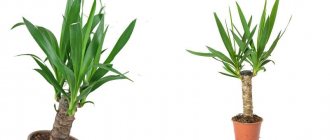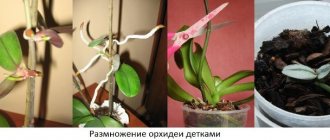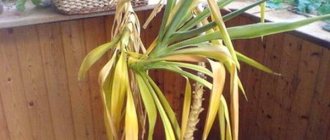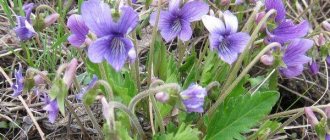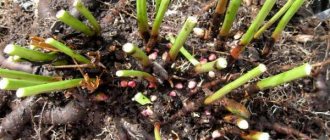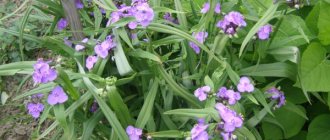Yucca garden is a close relative of the popular indoor plant. But if in potted culture its unusual, stylized “palm tree” shape is valuable, the street counterpart is interesting for its chic inflorescences up to one and a half meters long and half a meter in diameter. A fascinating sight!
Previously, the flower was cultivated mainly in the south, but now it can also be found in the gardens of the middle zone, where it forms truly “heavenly thickets.” We decided to figure out how difficult it is to care for a resident of semi-deserts, how to help her adapt to the Russian climate and preserve her in the conditions of a frosty winter.
Each yucca inflorescence contains 200–250 bells, which remain decorative for 1.5–2 months
Why is pruning needed?
Pruning allows you to give the flower a beautiful shape. A young plant looks good in a pot, but as it grows, it stretches out and lacks splendor: the trunk is thin, there are few green leaves. Therefore, the top is cut off and the branching process is started in a similar way. The crown becomes richer, and the flower itself looks more alive.
Yucca grows quickly; at home, the root system cannot always provide the crown with moisture and nutrients - when the stem is shortened, this problem disappears.
If the plant begins to die, then pruning is also carried out. This is how cuttings are obtained from which new specimens will grow. If the trunk has rotted, it is often possible to save the tops, which are used for further rooting.
Another reason for pruning is trunk curvature. A bent stem can break, which is very painful for yucca. In addition, there is a risk that the pot will simply fall under the weight of the leaves. Therefore, it is better to cut off the crooked trunk and allow the flower to grow new shoots.
The plant is also pruned if it is damaged by a pest or fungus. More often this happens with yucca growing in open ground. In order to save the flower, all its damaged parts are removed and the plant is treated with chemicals. Leaves that have been cut are immediately disposed of so that the pest does not spread throughout the garden.
How does garden yucca reproduce?
Yucca reproduces by seed and vegetative methods. Yucca propagation by seeds occurs with the participation of butterflies of the Pronuba family, which pollinate flowering plants. The ripened seeds are collected in August and planted to produce seedlings in February. Seedlings are planted in open ground only in the second year. Since the process of obtaining new yucca seedlings by seed is too labor-intensive and time-consuming, requiring the creation of special conditions, for its cultivation in gardens, a simpler and more productive method is practiced - vegetative. Several methods are used for vegetative propagation of yucca.
- By cuttings. To do this, in the spring the apical shoots are cut at an angle and the cut areas are treated with activated carbon. The lower leaves of the cuttings are removed, leaving 4-5 leaves at the very top. After this, the cuttings are dried in the shade for 20 minutes. and planted in a moist substrate, buried 5-7 cm into the soil. When planting cuttings, they must be placed at a distance of 4 cm from each other. Then cover the entire planting with film or each individual cutting with a jar. If cuttings are carried out at the end of summer, they are left to overwinter, covered with leaves and agrofibre, and in the spring they are transplanted to a permanent place.
- Root suckers. To do this, the mother bush is dug up in spring or late summer. The side rosettes with part of the root system are separated from it. Separated young shoots are planted in fertile, well-aerated soil, having previously treated the root system with a growth stimulant, watered and slightly shaded. Root suckers can be separated from the mother plant every 3-4 years.
- Parts of the trunk. This method is used when there are dormant buds on the stem. To do this, it is necessary to cut the trunk with buds into pieces 10 cm long. Place the finished stem cuttings horizontally on previously prepared and moistened soil and press it into it. Planting should be sprayed every day. After 2-3 weeks, young shoots will appear in place of the buds. After this, the stem cuttings are taken out of the ground and cut into pieces, the cut areas are treated with activated carbon and dried for 20 minutes, and then planted in moist soil, covered with a jar or film. After 1-2 months, the rooted cuttings can be planted in a permanent place.
When to prune?
It is necessary to prune when the flower has become too large - more than 50 cm. When deciding on this, you should take into account that after removing the top, the trunk will no longer grow. Therefore, it is better to wait until its diameter is 4–6 cm. A thicker stump not only looks more beautiful, but can also hold several thick caps of leaves.
It is important to choose the right time. The end of February or the beginning of March is suitable for pruning yucca. During this period, the plant has not yet emerged from dormancy, but is already ready for rapid spring growth. April and subsequent months are not suitable, as active growing season begins, so serious manipulations can destroy the flower.
In winter, yucca needs rest. No procedures should be carried out; watering should be reduced and the plant should be kept cool: the room temperature should be 10–15 degrees. This way the flower will gain energy and strength for subsequent growth and ejection of shoots: after pruning, new shoots will not keep you waiting and will form a lush crown in the future.
How to replant a yuca flower?
This is an evergreen plant , but in winter all its biological processes are suspended, and only in spring are vegetative processes restored. It is this period that should be used to transplant the flower. When changing its “place of residence”, it is important to try to preserve the root system of the garden yuca and prevent it from drying out. After transplanting, the flower should be left alone and not fed for at least a month. It is better to apply fertilizer in spring or summer before flowering, stop fertilizing a month before the autumn cold . This way the flower will be prepared for frost and will be able to survive the winter without harm.
How to cover a yucca for the winter?
The growing point in the heart of the rosette and the roots of the plant suffer the most from frost. A frame box, the size of which should correspond to the height of an adult plant, will help protect you from the winter cold.
The sequence of covering yuca before winter frosts is as follows:
- Before covering the yuca, the foliage is collected upward and wrapped with strong tape.
- Cover with a box and cover with fallen leaves or spruce branches.
- Wrap it in thick material and wrap it with tape.
Such a “sarcophagus” will reliably protect the plant and prevent it from dying in any winter frosts.
Propagation of garden yuca?
There are several methods for propagating garden yucca . Most often, propagation is used using daughter rosettes, which are formed at the base of an adult plant. It is necessary to take shoots with their own root system. This will help the plant acclimatize faster and get used to the new planting location.
Caring for the transferred rosette is the same as for an adult plant. It must be remembered that the cutting areas are highly susceptible to attacks by pests. Therefore, they should be dried a little and greased with cinnamon powder or charcoal.
Another way to transplant home garden yucca is to trim an adult plant (this method will also help to rejuvenate the yucca).
How to do it?
2 days before the procedure, the yucca is watered generously, this will help the plant stock up on water and reduce stress. You should prepare the necessary equipment in advance:
- pruning shears or sharp knife;
- alcohol;
- paraffin or any garden putty;
- anti-stress drugs for plants, for example, "Epin";
- Activated carbon;
- drainage, soil and container for rooting the cut top.
Tools must be well sharpened and treated with alcohol. This will allow you to make a quality cut and prevent the trunk from rotting.
The procedure is carried out carefully. You can significantly reduce stress for a flower if you strictly follow the step-by-step instructions.
- Determine the location of the cut. The length of the stump should be between 25–50 cm; this size is sufficient for the formation of young shoots.
- Hold the crown with your hand and make a cut. This must be done clearly, in one movement, completely cutting off the trunk and preventing it from breaking off. If the stem is broken, the plant's vascular system will be disrupted.
- The cut area should dry naturally. To do this, leave the plant alone for 2 hours.
- Treat the cut with garden putty or paraffin. This will protect the yucca from moisture loss and create a barrier against the penetration of harmful bacteria.
Autumn to winter
Indoor yucca is pruned in autumn and winter only if it is sick. If you remove the tops, you can grow a healthy plant from them. But the remaining stump will no longer produce new shoots. Therefore, if everything is in order with the flower, it is better to wait until early spring, and in the meantime provide the plant with rest so that it gains strength for subsequent growth.
It’s another matter if yucca grows in the garden, in which case it needs to be prepared for winter. In the fall, about 4 weeks before frost, cut off all yellowed leaves, dry shoots and flower stalks. The plant is sprayed with fungicides and its leaves are tied into a bundle. The soil is mulched with peat, the garden palm tree is covered with spruce branches or dead wood.
After flowering
At home, yucca rarely blooms. But if you create favorable conditions for it, beautiful white flowers that look like bells may appear in the summer. For this to happen, the plant needs a lot of light, good feeding and rest in winter. Before blooming, the yucca throws out an arrow, on which buds are formed.
After flowering, a bare stem remains, which does not look very aesthetically pleasing and spoils the appearance of the plant. Therefore, when the last petals fly off and the peduncle itself begins to dry, it can be cut off. This is done with sharp pruning shears at a slight angle to the very base. Also remove the lower line of leaves, which usually wilt and turn yellow.
How to prune yucca?
It is best to prune the plant in the spring, when it is just freed from its winter shelter. Since yucca has only one growth point, by cutting the stem, the gardener completely stops its vertical development. And yet the life of the flower will not freeze, the buds sleeping on the stem will wake up and give rise to several new rosettes.
Pruning is an excellent way to rejuvenate a flower, obtain strong garden yucca seedlings, and also to save specimens damaged by rot or frost.
Before cutting the yucca, water the plant a couple of days before the operation. The cut is made with a very sharp, clean knife so that:
- in its place there were no stem splits, damage or peeling of the bark;
- it fell 8 - 10 cm below the foliage growth line.
When the cut areas dry out a little, they, both on the stump and on the top, are treated with fungicide and charcoal powder.
The top of the hemp left to the ground after trimming the yucca can be covered with garden varnish, which will provide long-term reliable protection in the garden.
On an old plant, protected from the scorching sun, newer shoots will appear in 2–3 weeks. If the yucca is strong, 3 to 5 hatched buds are left on the stump. Small specimens will not be able to support the growth of more than two young tips.
The old top is not thrown away, but is used for planting garden yucca, the care of which is little different from the situation when daughter rosettes are transferred to the ground. True, before this the seedling needs to be rooted. It is best to do this in a greenhouse, making sure not to allow condensation to form and ensuring the moderate humidity of the sandy substrate.
Yucca filamentous - video
The narrow, sharp leaves of filamentous yucca evoke thoughts of palm branches and distant warm countries.
Indeed, its homeland is the eastern and southeastern territories of the United States; filamentous yucca is successfully grown in indoor culture.
At the same time, in the conditions of the middle zone, this exotic plant not only blooms spectacularly at the beginning of summer, but also overwinters in the open ground, withstanding twenty-degree frosts.
How does yucca overwinter at home? How to preserve and insulate yucca outdoors in winter? Do I need to cover it? We'll talk about this below.
Post-procedure care
After all the manipulations are completed, the yucca is given rest. It is left at room temperature in a slightly dark place for 14 days. It is necessary to avoid direct sunlight, at this time they are detrimental to the plant.
The first watering is carried out a week after pruning; the water temperature should be comfortable: 20–25 degrees.
After about a month or a little earlier, several buds hatch. When they sprout, it will be necessary to pinch off the excess shoots. This is done so that the trunk can support the grown crowns, which after a few years become quite massive. If the diameter of the stem is less than 5 cm, 2 or 3 shoots are left; on a thicker trunk, 4 shoots can be grown. Next, care for the yucca as usual:
- watering in the spring-summer period is carried out once a week, in winter - once every 3 weeks;
- from March to August, feed the plant; any fertilizer for succulents will do;
- provide the flower with a lot of light, especially in spring;
- Yucca loves fresh air, so in summer it is recommended to take it out onto the balcony.
In general, this plant is unpretentious and tolerates pruning well. If everything is done correctly, then new shoots will definitely appear on the sides of the trunk, which in the future will turn into a beautiful rosette of bright green leaves. Yucca will take on a bushy form and will look good in the interior of an apartment or office.
Yucca pruning - basic rules
How to prune and branch yucca? At home, yucca rarely branches on its own. The plant stretches greatly, reaches a height of more than 2 m and loses its decorative effect.
Plants whose trunks are at least 6 cm in diameter and 50 cm in height are pruned. Less thin trunks will not withstand the load.
The only time when this can be done relatively without damaging the plant is the beginning of spring. At this time, the plant begins to emerge from the state of forced dormancy, in which it remains from October to February.
Yucca blossom
A plant pruned after the start of active growth will not cope with simultaneous nutrition of the vegetative mass and healing of wounds. In such cases, yuccas often die.
How to trim yucca at home? For pruning you will need:
- sharp garden knife;
- alcohol solution;
- liquid paraffin or garden varnish.
The cutting location is chosen depending on the preferred height. The optimal height is 10-15 cm from the lower leaves. This size works well for standard room heights.
Plants with multiple trunks are pruned at different levels. In this case, new shoots will not interfere with each other. The crown of the plant will develop evenly, without skewing in one direction.
1-2 days before the procedure, the yucca is watered generously. The pruning tool is disinfected with alcohol, and the place for the cut is marked.
Yucca after pruning
The leaves of the plant are clamped into a bunch with the left hand, and a cut is made with the right. It is important to carry out pruning with clear movements, trying to avoid creases and damage to the cambium.
After this, the sections are poured with liquid paraffin or treated with garden pitch.
It is not recommended to trim several large trunks at the same time. The plant most likely will not cope with the healing of large wounds. Pruning of such yuccas is carried out over two seasons.
The trimmed plant is placed in a warm and bright place, preventing direct sunlight. It is important to try to ensure that as much light as possible reaches the lower top of the plant.
In some cases, pruning yucca may be necessary for medicinal purposes. It is carried out when the trunk rots, cutting it down to living tissue. Therapeutic pruning can be carried out at any time.
Since the volume of vegetative mass decreases several times, watering of yucca is significantly reduced. It is recommended to water no earlier than 2 weeks after pruning. Subsequent irrigation is carried out after the earthen clod has completely dried out.
Under favorable conditions, after 7-10 days in young plants and about 20 in old plants, you can notice the awakening of dormant buds on the trunk near the cut. Subsequently, the yucca is cared for according to the recommended rules.
Expert opinion
Yulia Yurievna
I have a large garden and vegetable garden, several greenhouses. I love modern methods of cultivating plants and mulching the soil, and I share my experience.
Ask a Question
Yucca pruning should be carried out with clean and disinfected tools, which is especially important if the plant is infected with an infection and the purpose of the procedure is sanitation. After the knife or pruning shears are used, they should also be wiped with a disinfecting solution. We would like to note that if you need the plant to be taller, you should not start pruning at a height of about half a meter. The thing is that after trimming the yucca, the stem will no longer grow. Even for sanitary purposes, it is better not to prune the flower in winter. This is a period of rest; if the plant is injured, it may not recover at all. At this time, it is advisable not to disturb such a flower at all. Watering is reduced, and the temperature should be set at 12-15 degrees. To avoid direct sunlight, it is best to create a protective screen for the plant from thin paper on a window glass. This will allow the flower to avoid burns, but still receive enough sunlight, which is required for recovery. Watering is required approximately 7-8 days after pruning. It is important that during the period of restoration of hydration, do not use cold water, because the immunity of the yucca plant is already reduced by pruning. When new shoots appear on the plant over time, some of them need to be removed. This is important so that the culture does not become depleted. Subsequent care, once the yucca plant has been pruned, consists of watering once a week during the period of active development. When the plant rests in winter, it needs to be moistened no more than once every 20-25 days. To make the crown dense after formation, it is important to feed your pet correctly for good branching. To do this, from the beginning of spring to the end of summer, you can apply complex mineral products. We would like to add that this culture loves fresh air, for this reason it is important to ventilate the room where the flower is located, and in the warm season, take the plant out to the balcony, veranda or garden.
Reasons for pruning
At home, the false palm tree grows slowly and often forms a single trunk. A long and thin bare trunk with a skirt of leaves at the top looks ridiculous, so the plant needs to be shaped.
The need for manipulation also arises when a side shoot grows in an inconvenient place, for example, near the soil surface, which spoils the appearance of the bush.
Yellowed or dried leaves require removal for sanitary purposes. Also, health manipulation is needed if the trunk at any stage of growth begins to bend. Such a plant can turn over under the weight of foliage on a crooked trunk.
Preparing for winter and wintering
Particular attention is paid to preparing yucca for winter. The amount of work depends on whether your region needs to cover it for the winter or not.
Wintering without shelter
In the south of Russia and Ukraine, where frosts, even if they drop below 20 ° C, then only for a short time, yucca overwinters without shelter. You don’t have to do anything at all, but in this case the bushes will look unkempt after wintering, some of the leaves will break under the weight of snow and gusts of wind, and some will freeze. Moreover, not only the outer leaves will suffer, but also the middle of the bush. What should I do to avoid this?
Read also: Grill area at the dacha photo
Before the onset of persistent cold weather, the bushes need to be tied, collecting the leaves of each rosette into cones. This will prevent them from being damaged by snow. In addition, the more delicate core with the apical bud will be protected by several layers of dense leathery leaves. To protect the rhizome from freezing, the soil around is mulched with humus, peat chips, and leaf litter.
In most cases, such preparation is sufficient for successful wintering of filamentous yucca in the Krasnodar region, Kuban, Rostov region, and Crimea.
In the photo - filamentous yucca, prepared for winter
Options for constructing shelter structures
Garden yuccas growing north of these regions require shelter for the winter. Again, they can be of varying degrees of complexity and “warmth” - this is usually learned through experience.
- Sometimes it is enough to wrap the plants tied in bunches with a breathable covering material - spunbond, lutrasil. The cone is tied with twine at the top and pressed down with something heavy at the bottom or buried in drops.
- The second option is to cover the bushes with a frame made of wooden slats and wire. Covering material is thrown over the structure, and spruce spruce branches and reeds are piled on top.
- Where winters are too harsh (Ural, Altai), tied and mulched yucca is covered with a wooden box, pieces of foam plastic, fallen leaves, and spruce branches are placed on top. All this is covered with film.
When covering the yucca for the winter, make sure that there is an air gap and that it is dry inside. And then, from the first days of spring, the plant will delight you with perfectly preserved evergreen foliage.
In spring, do not rush to remove the covering material. Wait for cloudy weather, leave the shade on the south side for a day or two, and do not forget to clean the bushes of damaged leaves. All. The exotic beauty is ready for the new season.
Author: Tatyana Zadorozhenko
Rules of procedure at home
Before starting the process, try to imagine the appearance of the plant after the manipulation. Please note that after pruning, the palm tree stops growing the main trunk, its thickness also remains the same, only newly formed shoots grow. Therefore, the plant is formed when it reaches a certain length of 50-70 cm.
Necessary tools and preparations
To carry out the manipulation, in order not to be distracted, you need to immediately prepare everything you need:
- a sharp knife with a wide blade or pruning shears;
- medical alcohol;
- cotton pads;
- Activated carbon;
- beeswax.
Technology
The plant needs preliminary preparation: abundant soil moisture for 2-3 days. The technology is the same in all cases; there are only a few nuances that take into account the purpose of pruning and the shape of the crown.
Sequencing:
- Wipe the surface of the cutting tool with a cotton pad soaked in alcohol.
- A cut is made in one directed movement.
- If the trunk thickness is up to 5 cm, the cut is made above 2 buds; more than 5 cm, 4 buds are left.
- The cut is treated with powdered coal and left for 1-2 hours.
- Afterwards, the cut area is covered with wax, which prevents the penetration of bacteria.
Yucca description
When cultivated in open ground in central Russia, 3 types of yucca are practiced:
- filamentous - this shrub got its name from the thin fibers hanging along the edges of the hard leaves. This is one of the most frost-resistant species of yucca, able to withstand temperatures down to -30° C for a short time. Its almost stemless rosette consists of spirally arranged, erect, blue-green sword-shaped leaves about 70 cm long and up to 4 cm wide, pubescent with twisting threads. When flowering, it throws out a flower panicle up to 2 m high, densely covered with drooping, yellowish-white flowers, in place of which, after flowering, seed pods up to 5 cm in diameter are formed. A variety of yucca filamentous are variegated forms - shrubs with white or yellow-pinnate leaves. The most common variegated varieties of filamentous yucca are “Bright Edge” and “Color Guard”, “Gold Heart”, “Ivory Tower”;
- glorious - a type of yucca that grows into a spherical bush or tree up to 2 m tall. The dark green leaves of this shrub have a bluish coating, jagged edges, with a prickly thorn at the top of the leaf. The length of the leaf plate reaches 60 cm. Its peduncle is up to 2.5 m in height, covered with large creamy-purple bell-shaped flowers.
- glaucous is a type of yucca characterized by a short trunk, long narrow gray-green leaves and a tall peduncle with a racemose inflorescence of greenish-white flowers. Another name for this species is “Holy Candle.”
In the southern regions, Yucca ivory, Yucca avolifolia, Yucca Schidigera, Yucca rostrata, Yucca scotti, Yucca aloelia, Yucca gloriosa and other species also grow well.
Yucca usually blooms 3-5 years after planting in June or July. When grown in the southern regions, it can bloom twice a year - in summer and autumn. In landscape design, yuccas are used in single and group plantings, planted in rockeries, flower beds, and along fences.
Pruning garden yucca
In principle, there are no special differences from pruning an indoor specimen. The main difference is that the procedure is carried out twice, like with most garden plants. In spring, frozen, diseased shoots and foliage are removed.
Formative pruning repeats the procedure for indoor yucca, only a larger number of buds remain. The sections are treated with garden varnish or grafting wax.
You can prepare the product yourself:
- Buy “Ozokerit” (an anti-inflammatory drug) at the pharmacy.
- Melt both substances, taken in equal proportions, in a water bath.
- Mix well.
- The drug is applied to the cuts as a fungicide.
1-1.5 months before the onset of the first frost, the yucca is inspected and damaged or diseased leaves and dry flower stalks are removed. The sections are disinfected. As soon as the cuts have dried and healed, you can cover the palm tree for the winter.
How to root yucca in water
The cut tops of the yucca can be rooted by placing them in water. For this cutting site, it is necessary to dry it in air for half an hour, and then place the cutting in boiled, cooled water so that it covers only the part of the trunk free from leaves. In this way, parts of trunks with dormant buds can also be rooted. For stem cuttings, the lower sections are treated with a growth stimulator, and the upper ones with a fungicide or activated carbon, after which they are placed in water so that the buds are above the water. It will take about 1-2 months for new roots to grow, after which the cuttings can be transplanted into the ground to a permanent place.
Post-procedure care
The successful outcome of pruning depends on caring for the plant afterwards. The flowerpot is placed in a warm place with a temperature of +20…+23°C. Lighting should be dim for about 2 weeks; for a garden specimen you need to come up with a sun canopy.
Water once a week for the first month. Water for irrigation is settled, its temperature corresponds to the air temperature in the room. After the shoots appear, depending on the diameter of the trunk, some part is removed. (Diameter 5 cm, will not withstand the load of more than 3 developing stems.)
Two weeks after pruning, you need to feed the flowerpot: apply fertilizer one leaf at a time. The first fertilizer can be wood ash, which also has a fungicidal effect (mixed with water 1:3). Subsequent feedings until autumn are applied once every 3 weeks. They mainly use balanced mineral complexes for succulents, for example, “Bona Forte”, “Good Power” (the proportion is halved from that given in the instructions).
A garden plant can be fertilized with organic matter: an infusion of cow manure diluted with water 1:20. After rooting, the flower needs bright light, but without direct rays of the sun hitting the foliage. During dry and hot periods, the foliage is sprayed.
Yucca filamentosa
Yucca Filamentous has another name, namely, “tree of happiness.” A very beautiful and interesting plant. It is quite unpretentious; caring for yucca is not very difficult. It's important to remember a few key points. The plant is native to North America. There are about 40 varieties of Yucca filamentosa, and there are specimens without a stem.
The plant consists of inflorescences forming a lush cluster. The height of the flower reaches one and a half meters. Yucca filamentous is a garden plant and can be found anywhere - from offices to large greenhouses. This is due to its resistance to frost. It is important to plant the yucca correctly and then it will be able to withstand frost up to 30 degrees and, surprisingly, bloom. Although it is still better to cover it for the winter.
If your region is famous for its harsh winters, then buy only an established, acclimatized plant, preferably from a local greenhouse, and be sure to ask the seller for details of winter care. Yucca filamentosa is a perennial plant; it will decorate your space for a long time if you care for it correctly. They say that yucca brings good luck and happiness to the house; in order for it to bloom for a long time and make you happy, you need to master the science of caring for this plant.
Yucca filamentosa. Plant care and planting
Planting Yucca filamentosa. There are no fundamental requirements regarding the composition of the soil. The main thing is to avoid waterlogging, otherwise the roots of the filamentous yucca will begin to rot. You can save the yucca by removing most of the root and replanting the yucca filamentosa in a flower pot. And only a year later, when the yucca grows out, you can plant it again in your garden, but this time according to all the rules. And the rules are as follows: filamentous yucca should be planted in a place where there is no danger of overwatering.
A place suitable for filamentous yucca is on a slope, with light partial shade from trees. Although in fact it can grow even on sand, the main thing is to provide it with conditions that are far from damp and water less, even in the wildest heat.
Drainage is also important. A hole for planting filamentous yucca must be prepared at least 80 cm deep and with a diameter of at least 40 cm. Then pour pebbles or fragments of brick into the hole, 5-10 centimeters, and then fill it halfway with coarse sand, or even better, fallen leaves (they are valuable as fertilizer), mix sand with ash - this will only improve the effect.
Much also depends on the composition of the soil on the site. And if the soil is more sandy, then you can already plant. If your land on the site is loam or black soil, then immediately before planting, “dilute” it with sand.
As you already understand, you need to water filamentous yucca carefully. If the summer season is not dry, then natural watering is enough, and in case of drought, once a week is enough. A couple of times a season, feed it with complex mineral fertilizer, and in the third year (when the roots have finally become stronger), you can also feed it with organic waste. It is not necessary to replant filamentous yucca; it can grow in one place for decades.
To prepare yucca for the winter season, you need to tie the leaves into a bunch and place more fallen leaves on the roots - this will help save the plant from hypothermia.
It is very easy to propagate yucca filamentosa - with the help of lateral shoots, which, if not weeded in time, will turn your plant into a large and sloppy bush. Follow these conditions for caring for this beautiful plant. And remember: it begins to bloom not in the very first year after planting, but at least three years later.
In the garden, yucca filamentosa will make a good composition with lower flowers - tobacco, nasturtium or pansies and can become its main decoration.
Recommendations from flower growers
Beginners in floriculture often make mistakes that lead to dire consequences.
Advice from experienced plant growers will help you avoid them:
- For successful pruning, it is advisable to allow the plant to grow a trunk diameter of at least 5 cm.
- Outdoor specimens are pruned in warm, windless and dry weather.
- More than 5 buds left on the stump can create an overload for the yucca.
- During the dormant period, the pot is transferred to a cool room up to +15°C.
- Close proximity to operating heating appliances is not allowed.
- When watering, you need to focus on the speed of drying of the soil; overwatering is destructive.
- It is imperative to disinfect working tools, soil, containers and flower cuts, otherwise disease cannot be avoided.
Video: How to properly trim a yucca trunk
Yucca is popular both in home floriculture and in garden landscaping; it is a frequent decoration of offices and administrative buildings. One of the simplest and easiest plants to grow, after proper pruning, will delight the eye with a decorative, lush crown.
Reproduction
Garden yucca is propagated in different ways. To achieve good results, you need to strictly follow the technology.
How to propagate yucca from tops
This is the most popular method. To implement it, you need to take a rosette of leaves at the top. A broken branch will also work. The cuttings need to be dried for 2 hours and the lower leaves removed. Then it is planted in nutritious soil and covered with a jar. The ground should be slightly damp.
Cuttings
Yucca propagates by cuttings in the first half of spring or at the end of winter. Usually the procedure is carried out on an adult plant, during the formation of the crown, when excess shoots are removed. The cuttings should be dried for 1 hour and transplanted into a mini-greenhouse. After 1.5 months, roots will appear. At this point, the plant can be adapted to normal conditions.
We plant the lateral shoots
To plant a growing yucca, you need to make an incision at the root. It is performed below the lower leaves by about 40 centimeters. In this area, you need to remove 1.5 centimeters of bark. A layer of damp moss is applied to the damaged area and wrapped in film. This helps prevent moisture evaporation.
After some time, dormant roots awaken in this area. As they grow, they form cuttings. When the roots have grown sufficiently, the cuttings are cut off. The cut must be treated with crushed activated carbon and placed in the substrate.
By shoots
In such a situation, it is necessary to separate the excess shoots, which lead to excessive plant density. In this case, the cuts must be sprinkled with charcoal to prevent rotting. Then it is recommended to move the sprouts into coarse sand and place them in a greenhouse for rooting.
It is recommended to water the seedlings moderately and periodically ventilate to remove condensation. With adequate care, the first roots will form within 1.5 months. Then the plant can be moved into a pot.
Stem cuttings
This method is suitable for qualified flower growers. After cutting off the tops, the plant is left with trunks without leaves. The length of the flower trunk must be at least 25 centimeters. All cuts should be lubricated with garden varnish. You can also use activated carbon. Then a root formation stimulator is used. After the necessary manipulations, the trunk should be planted in nutritious soil.
Air layering
This method should be used to plant yucca during rehabilitation after illness. To do this, you should take only hard areas. Remove the bark from the bottom cut and cover it with moss. It needs to be moistened periodically. After 1 month, small roots will form. They should be grown to 5 centimeters. The yucca is then planted in suitable soil.
Yucca garden is a popular ornamental plant that is easy to care for. To get a strong and powerful crop, you should monitor watering. It is also recommended to prune the bush and apply fertilizer.
Caring for garden yuccas
Garden yuccas are considered one of the most popular plants today. The fashion for sword-shaped leaves and strict forms, along with the ongoing trend of growing exotics atypical for the local climate, have made yucca a widespread star. To admire the lush bushes and luxurious inflorescences of yucca, it is not enough to choose the right growing conditions. This plant also needs attention and regular care. We will tell you in this article how to properly care for yucca in the garden.
Yucca is a decoration for any garden. © Jon Orue
Content:
Yucca garden diseases and their treatment
Yucca garden is a plant that is often affected by diseases and parasites. It is necessary to carefully monitor the condition of the bush and take timely measures to combat them.
Treatment of diseases
Most often, garden yucca suffers from the following diseases:
- Anthracnose . Symptoms appear as brown and brown spots on the leaves. Occurs due to high humidity. To combat anthracnose, you need to spray the bushes with a solution of Fundazol (30 g per 4 liters of water).
Spraying required
- Powdery mildew. The disease occurs when high humidity and cool weather combine. A white coating appears on the plant. Treatment is carried out using “Topaz” (40 g per 5 liters of water).
- Cercospora blight. The disease appears if you frequently water the crop. Symptoms consist of brown raised spots. To get rid of signs of the disease, treat the bushes with Fundazol solution. Dilute the drug according to the instructions. Carry out the treatment every 10 days.
Control of parasites
The following pests can be seen on yucca bushes:
- Slugs . You can get rid of them using insecticides.
- Shield . To eliminate parasites, wipe the leaves with a wet cloth. You can also spray the bushes with Actor.
- Spider mite . The drug “Iskra” helps fight it.
Features of caring for yucca in the middle zone
Yucca can hardly be called an easy plant to grow. This statement, however, is relevant only for a harsh climate, if it differs sharply from the yuccas, which are accustomed to completely different conditions.
Garden yuccas grow well only in light, sandy or rocky, nutritious, very loose soil and in places where there is no risk of stagnant water. Soil drainage and protection from getting wet and flooding is the key to growing yucca in the middle zone. But the choice of a sunny location and protection from the wind also play an equally important role. But even the right choice of location does not guarantee that the yucca will not die if it is not provided with proper care.
Due to its drought resistance and endurance, yucca does not require systematic watering or complex fertilizing. The basis of caring for this plant consists of completely different procedures: taking care of the air permeability of the soil, proper shelter for the winter and careful pruning. Caring for yucca is not very difficult, but in the absence of experience, the risk of losing the plants even before flowering is high. You need to carefully monitor changes in conditions, monitor the weather and adjust care accordingly.
You can also grow these garden plants in containers and overwinter them indoors. Caring for yucca is no different from any other potted or tub-based exotic plant, but the plant requires much more careful watering and fertilizing.
Winter in the open ground
Is it necessary to cover garden yucca for the winter? What preparations are needed for winter? The main problem of keeping yucca on the site in winter is to provide a sufficiently dense, reliable shelter and at the same time avoid dampness under it so that the leaves do not rot.
Young plants experiencing their first winter can be covered with plastic containers in which drinking water is sold, with the bottom cut off. Such a container is pressed as deep into the ground as possible and sprinkled well around the edges so that it does not get torn off by winter winds.
In the fall of an adult filamentous yucca , after the first night frosts, in dry weather the leaves are tied into a common vertical bunch in order to maximally protect the central growth rosette. A hut of meter-long stakes is arranged around the tied plant, covered with a suitable material (spunbond, lutrasil) and the edges of this material are secured.
How to cover a yucca for the winter? Photos of various winter shelter options for different climates.
In the spring, after the shelter is removed, in case of frost, the leaves are again tied into a bundle, and they are finally released only after the threat of frost has passed. Damaged parts are cut off.
If the winters in the region are not too harsh , you don’t have to build a hut. In this case, the tied leaves are additionally attached to a peg support; the root circle is insulated with fallen leaves, mulch or an earthen roll 15-20 cm high.
If severe frosts are expected , an air-dry shelter is installed, consisting of a wooden box, which is covered with insulation (spunbond, lutrasil, polystyrene foam). A layer of fallen dry leaves is laid on top, and then this winter shelter is covered with plastic film, which is sprinkled around the edges. As a rule, yucca retains its leaves under such cover.
In the conditions of the middle zone, the American exotic - filamentous yucca - is able to successfully overwinter in the open ground under a properly constructed shelter and bloom with renewed vigor in the summer season, delighting not only with a one and a half meter “candle” with creamy bell flowers, but also with a pleasant evening aroma.
If you find an error, please select a piece of text and press Ctrl+Enter.
Yucca is a southern flower, similar to a palm tree, reaching 2 meters in length, but there are specimens much taller. This plant looks gorgeous in the interior, especially in a large space, such as a hall or living room. Long green leaves fill the room with fresh tropical greenery and exoticism. The main thing is to form the yucca correctly and achieve the appearance of lateral shoots.
Yucca moisture requirements and watering
It is better not to water yucca than to overwater it. Yuccas cannot tolerate dampness or stagnant water in the soil, so you should try to water it correctly. But, in general, the drought resistance of a plant can surprise even at the flowering stage. Watering the yucca is carried out carefully, without soaking the leaves of the plant, but still, even in the midst of the summer heat, it is better to do without it.
Yuccas grown in pots or tubs are watered as the soil dries, allowing it to dry completely or almost completely between waterings.
Yucca flowers. © Christy Kilgore
Is it necessary to cover yucca for the winter? How to cover yucca for the winter
How does Yucca filamentosa overwinter?
Left: Yucca filamentosa.
Yucca filamentosa is capable of growing and wintering in the Moscow region and central Russia, but it is necessary to take into account some important aspects of its cultivation and wintering.
First, about planting material: purchase a yucca seedling that has already been acclimatized to local conditions (buy yucca from a local plant nursery or from private sellers in your area).
Secondly, to plant yucca, choose a suitable place in the garden: always sunny and with a slope (plant yucca on a slope to drain moisture). For yucca, non-clayey, well-drained soil is desirable (take care of reliable drainage when planting).
Thirdly, the yucca needs to be covered for the winter to protect it from the cold. Otherwise, during severe frosts, the entire plant may die completely, or the top of the yucca may freeze, and the leaves may fall off. Even if the affected plant does not die in winter, it will lose its beauty. In spring and summer, yucca will take a long time to recover; may not bloom after an unsuccessful winter.
Winter air-dry shelter for yucca is prepared similarly to shelter for roses. The plant is covered in the fall with a wooden frame in the form of a box, the frame is covered with a covering material (spunbond, lutrasil, etc.), an insulating layer of leaves is placed on top and around the frame, and finally a whole polyethylene film is laid on the cover. Such a shelter ensures the presence of air inside the shelter and blocks access to atmospheric moisture from the outside. As a result, yucca retains its leaves in winter and does not suffer from the cold.
Loosening the soil and weeding
One of the important procedures that is best carried out on time is loosening the soil. Soil permeability for garden yuccas is very important, and regular prevention of soil compaction and crusting will allow the plant to achieve the best winter hardiness and the most abundant flowering.
Small weeds do not bother yuccas, but it is better to carry out weeding in a timely manner.
Yucca gratefully responds to mulching, but for the plant it is better to use materials that act as top drainage. Yuccas look great with stone chips or screenings, decorative mulch.
Yucca garden planting and care photo
There are two types of yucca, which are suitable for growing in open ground. This:
- Yucca filamentous;
- Yucca Slavnaya.
The filamentous one wears its ignorance because of the long fibers that are counted from the edges of the long foliage. This type of yucca is more common in Russian plantings, as it has good frost resistance.
Read also: How to properly pour pancakes into a frying pan
Evergreen is easy to distinguish from other plants by its pointed and lanceolate leaves. The width of one leaf is only 3-6 centimeters, and the length can reach 50-70 cm. When the plant grows, the lower leaves wither and create a so-called “skirt” around the trunk.
With good care, yucca should bloom every year. Peduncles reach one and a half and sometimes two meters in length. And when yellow and pink bells (from 50 to 180 pieces) with a diameter of 6 cm open on it, Yucca amazes with its beauty and does not leave even the most enthusiastic cynics indifferent.
Pruning garden yucca
Although in warm climates they experiment with yuccas by forming standard forms by removing the lower leaves, in the middle zone pruning comes down to the timely removal of the peduncle and leaves damaged during wintering.
Yucca flower stalks are cut off when the inflorescences begin to turn brown. Use sharp and clean tools for cutting. The cut is made at an angle and to the base of the shoot.
If the yucca leaves freeze during wintering, then the dry leaves are removed from the bushes. If breaking off the leaves is inconvenient, you can trim them with a sharp knife or pruning shears, leaving a small base. Removal of limp and dry leaves is carried out both after planting and when the decorative appearance of the plant has suffered due to any health problems.
If you want to get the most massive plantings possible and quickly stimulate the growth of lateral rosettes and new plants, you can cut off the central peduncle of the mother yucca, thereby stimulating the development of lateral buds and new rosettes.
Video propagation of garden yucca
This video will help you learn more about the intricacies of propagating garden yucca.
Since yucca is very unpretentious in its agricultural technology, you should definitely allocate a place in the flowerbed or adjacent area for planting it. And she will thank you with spectacular flowering.
Feeding for yucca
For garden yuccas, especially in conditions with harsh winters, excessive feeding is dangerous. It is best to limit yourself to one single procedure - early spring feeding. Fertilizers are applied after the soil has thawed, either by working them into the soil or by watering the plant with a solution.
For yucca, it is preferable to use complete mineral fertilizers in an easily digestible form. You can limit yourself to organic fertilizers, in particular compost.
Container yuccas are fed with organic, complex or complete mineral fertilizers, applying them once a month in the dosage recommended by the manufacturer, from May to August.
Yucca leaves are decorative all year round. © Dan Kristiansen
Yucca wintering
Despite its exotic status, thanks to its deep and powerful root system, filamentous yucca, like other garden yuccas, has sufficient frost resistance to survive the winter even in regions with harsh winters if properly covered. Despite the declared winter hardiness limit down to -20°C, it can withstand even more severe frosts under proper conditions.
A winter shelter for yucca should reliably protect the plant not only from cold, but also from waterlogging. But the shelter also has another important goal - preserving foliage over the winter, thanks to which the yucca will not spend the entire spring restoring greenery, but will look good even at the beginning of the season, delighting with the size of the bush and lush flowering.
You can limit yourself to simple hilling and mulching, but the most reliable option in the middle zone is an air-dry shelter. Before covering, it is better to tie the yucca leaves and mulch the soil with dry materials.
You can protect yuccas from getting wet, even in the event of abnormal weather, by installing a simple box or wooden box over the plant. A layer of insulating material (foam, spunbond or non-woven materials, a thick layer of dry leaves and a waterproof film will allow the bushes not only to successfully survive extreme frosts, but also to preserve the foliage. For yucca, any other air-dry method is suitable, as well as frameless hilling with simple wrapping with protective materials.
Without shelter, yuccas may also not die, especially if there is a snowy winter. But their central bud very often freezes out, the plant recovers slowly, forming modest and undecorative daughter bushes due to underground stolons.
The yucca cover is removed gradually in the spring, layer by layer. They begin to unwrap by slightly opening the film in March and finish by removing the cover only in April.
For the winter, with the arrival of the first frost, container yuccas are removed to bright and cool rooms. Yucca can be left to winter together with the main tubs and potted perennials, at air temperatures from +2°C to +5°C. The maximum temperature for wintering container garden yuccas is +12°C.
Yuccas in the garden. © els vanderpalen
Care
Yucca is considered one of the most unpretentious exotic garden plants. Even in unfavorable conditions, active growth and lush flowering can be achieved. In order for the flower to look healthy and regularly delight you with its beautiful flowers, minimal care should be taken.
Watering
When growing outdoor yucca, you should be careful about watering. The plant does not tolerate high humidity, reacting to excess water by changing the color of the leaf blades and deteriorating the structure of the rosette. Watering should be moderate as the top layer of soil dries. When there is an excess of moisture, the roots rot, and when there is a lack of moisture, the leaves curl, and in filamentous varieties the threads droop.
You can use rain, melt or remaining water at a warm temperature. To enhance growth, you can add a little biostimulant with an increased nitrogen content every 2 weeks. It is advisable to water the plant at the root so that no excess moisture remains on the surface. During flowering and in dry weather, it is recommended to additionally spray the leaves with cool water.
Top dressing
In the first two years of life, it is necessary to use complex mineral fertilizers for succulents or exotic plants. Fertilizer is applied for the first time in May before the beginning of the growing season, and then in the fall after flowering ends. This scheme must be followed for the first two years of growing a flower.
Starting from the 2nd year of life, you can add organic matter (a solution of mullein or bird droppings, compost). An adult yucca is fed in the second half of April, and a few weeks before the growing season (the first ten days of June), 30-40 g of superphosphate should be poured up to the roots. There is no need to water the mixture, since after rain it will naturally fall into the soil.
Pinching, pinching and pruning
The pruning procedure is necessary to rejuvenate the plant, as well as stimulate active growth. In addition, shoots and seedlings after pinching can be used for subsequent planting - yucca takes root well if the temperature conditions are met.
It is advisable to prune in the spring after removing the winter cover, or in the fall after flowering has ended. Since there is only one growth point on the plant, when the stem is trimmed, its development completely stops, but it starts again when the dormant buds awaken. Step-by-step trimming algorithm:
- Two days before the procedure, you need to completely stop watering.
- The trunk is cut off with a clean and sharp knife or pruning shears so that the condition of the bark at the cut site is not disturbed. The cut should be made 7-9 cm below the level of leaf growth.
- After 10-15 minutes, treat the cut with a solution of potassium permanganate and sprinkle with charcoal. It is also recommended to apply a garden varnish to reduce the likelihood of infection.
- New shoots should normally appear after 14-20 days. In comfortable conditions, up to 5 young shoots appear on the plant.
The trimmed part can be used for subsequent planting. To do this, the shoot is transferred to a less illuminated place and deepened into sandy soil. After rooting, the seedling is transplanted to a permanent place.
Loosening, mulching
The area next to the yucca needs to be regularly loosened and weeds removed. The procedure is important for the root system, since the flower does not grow well in dense soil. Loosening is carried out at least 3 times per season, as a crust forms on the soil surface.
At the same time, mulching can be carried out to retain moisture and reduce the growth of unnecessary plants nearby. Sawdust or fallen leaves are used as mulch.
Transfer
To enhance growth and abundant flowering, an adult plant that has been in one place for more than 3-4 years must be transplanted to a new place. You can understand the need for transfer by looking at the state of the outlet and the sheet plates. They become dull and the color intensity decreases. The rosette becomes loose, wrinkles and threads appear.
The procedure is best carried out in spring or autumn so as not to disturb the yucca during the growing season. You need to dig up the flower very carefully so as not to damage the powerful root system. It is best to transfer the plant along with a lump of earth into a previously prepared planting hole. After transplantation, you should fertilize the yucca with a complex composition. After this, flowering will occur only next year.

